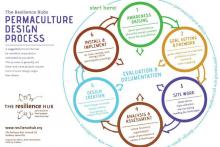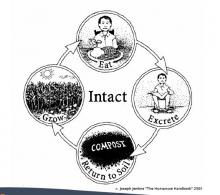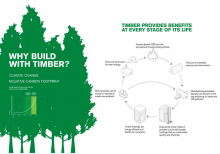Beyond Energy*
Whole Property Retrofit: Redesigning Suburbia for an Uncertain Energy & Food Future
How do we turn the "problem" of suburbia into an enormous opportunity to create a set of resilient systems that can adapt to a changing world? Learn how a holistic design process and a whole-property retrofit in Maine has created a suburban model of living that requires significantly less time, money and energy to run while simultaneously enhancing the thermal comfort and well-being of the residents. This case study presents a transferable suite of findings on efficiency, renewables, integrated landscape elements, food production, transportation and “incremental deep energy retrofitting” which have weaned this eighty-year-old home completely off of fossil fuels.
Calculating the Life Cycle (Cradle to Grave) Impacts of Buildings
It is a tall order for humanity to become healers of the planet. In order to do so, people need to tap into new avenues of influence that are not yet sufficiently explored and identified. It is essential to lessen the environmental impacts of buildings in ways extending far beyond operational energy and carbon by considering a holistic view of material and energetic flows across a building’s full life cycle.At the same time we must consider how to give back to the planet and create a regenerative future. This workshop will demystify the important practice of life cycle assessment (LCA) and inspire with an overview of handprinting,which identifies how we not only do less harm, but change things for the better.
Participants will gain the skills needed to calculate the life cycle impacts of buildingsacross their full lifecycle – material production, transport and construction, material replacement and maintenance; and finally material disposal or re-cycling, and to use the results during the design process to evaluate design options and identify low-impact solutions. In the afternoon, participants will learn about the current state of the science of LCA practice, how to interpret and compare LCA results, and the integration of LCA into certification schemes, such as LEED and the Living Building Challenge. Presenters will share case studies in which LCA informed design decisions on built projects and participants will generate a series of comparative LCAs using Tally, a Revit-integrated LCA tool. Participants are encouraged to bring examples of material, assembly, or whole-building LCAs and their thoughts and questions about this emerging practice.
Reimagining Human Waste as an Opportunity: Water Savings and Urine Reclamation
Leaders of one of the world’s largest toilet manufacturers and a visionary nonprofit will share stories from the leading edge of current water conservation technologies, and a future of entirely new approaches to managing human waste. Come hear about and engage with the latest science on the life-cycle impacts of toilet manufacture and use, and on cost-effective ways to reclaim nutrients from the waste stream. This is an opportunity not to be missed!
A How-to Guide to Carbon-Neutral Cities
At NESEA we know how to make really good buildings. But we can only solve so many problems with better buildings. We need to start working just as collaboratively and thoughtfully on making better cities and regions. In this full-day workshop, you’ll have an opportunity to engage with real-world practitioners from three different countries whose home cities have established quantifiable plans for achieving carbon-neutrality within our lifetimes. The goal of this workshop is to provide participants with the framework and tools to go back to their own communities and do the same. We’ll look at support provided by national, regional, and local governments; the role of carrots and sticks; ways to engage the private sector; and the import of public perception, opposition, and support. Participants will have a chance to review the plans each municipality has developed and challenge the planners with the hard questions about dream versus reality.
Sketching with Numbers
It’s about time we stop ignoring the full impact that design, construction and development really have. We cannot stop at net zero operational energy but instead need to consider all of the aesthetic, carbon, embodied energy, community, and financial impacts of work. No one ever said socially and environmentally responsible development would be easy, but that doesn’t mean it is impossible. This workshop will look at how Placetailor incorporates quantitative analysis into the design phase of small-scale residential development work to create dwellings that are architecturally interesting and super insulated, have lower embodied carbon, are located in urban infill and are based on an integrated analysis of finances and energy. This is a workshop about raising the bar, exploring the idea of a “net positive impact”, and getting hands-on experience using the Placetailor developed “Gizmo”, a spreadsheet tool that converts these conceptual inklings into practical analysis.
Combating Climate Change with Timber Construction
With its smaller carbon footprint, timber construction should be considered alongside steel and concrete to build both low and mid-rise projects. This session will introduce innovations in timber technology, and through case studies demonstrate the wide range of benefits including environmental benefits. With buildings in the U. S. accounting for 38% of all carbon emissions and with population growth on the rise, we must reconsider how we construct our buildings. Climate change can be combatted in two ways –by reducing carbon emissions and by removing carbon from the atmosphere – and timber is unique in that it is the only building material that can do both. Recent innovations in timber technology is paving the way for timber once again to become integral to the fabric of cities, at this pivotal moment in time.
Core Principles: Sustainability in Your Practice
The terms “sustainability” and “resilience” drive us to address a bigger, long term picture while managing the details at hand. The skills needed to accomplish this feat of ever-changing perspective are applicable to project work as well as to your own career development. The complex puzzle includes budget, program, existing mandates, aspirational goals, experiences and team temperaments and more. Learn how to ingrain sustainability in your practice and personal work approaches from Jodi Smits Anderson, Architect and Director of Sustainability Programs at DASNY, the NY State Construction and Public Finance Authority, and Jim D'Aloisio, Principal at Klepper, Hahn & Hyatt.
Success through Quality Management: Building a Stronger Company
Quality experts estimate that 25-40% of dollars spent by typical businesses is waste. Companies focused on quality spend less, reduce waste, cut operating costs, and invest in processes that result in: greater profits; stronger financial position; improved competitive capabilities; operational stability; greater customer success/satisfaction, and setting trends for the industry. Simply put, no service-based industry has ever made less money by doing things right the first time. For owners, partners, operation managers, and supervisors.
Cradle to Grave: The Concealed Energy, Carbon and Water Impact of Buildings
Buildings presently account for a third of the world's energy use, and the operational energy of buildings is projected to double between now and 2050. As the building sector grapples with its role in mitigating climate change, and environmental impacts more broadly, we must come to terms with a more holistic view of how building design, construction and use shapes the environment. All too often efforts to minimize environmental impacts of buildings focus solely on operational energy, carbon and water. However, this view neglects the concealed impacts across the wider building lifecycle: material extraction and manufacturing, transportation and logistics, construction, maintenance and disposal or reuse at end of life.
This presentation will explore the cradle to grave environmental impacts of building materials, assemblies and whole buildings across a range of environmental impact categories. The session will discuss the increased use of Life Cycle Assessment (LCA) as an assessment methodology and present tools that can be used by designers to integrate iterative LCA into their design workflow. The presentation will also explore how life cycle tools and perspectives are being leveraged to broaden our sense of what NetPositive or regenerative design fully means, and to identify ways that we can put the NetPositive ambition into practice now as a guide to decisions in the buildings sector and beyond.
Cities: How are Our Neighbors Doing?
Cities play critical roles in achieving our climate goals, and proactive approaches toward energy efficiency and clean energy drive economic development, revitalization, and local job growth. This session will provide a detailed look at the efficiency and clean energy plans in some of NYC’s neighboring cities – Philadelphia, Yonkers, and Albany– and discuss lessons learned from efforts to advance energy solutions. Such participation in city-to-city networks and city-state partnerships are particularly effective ways to unleash innovative solutions.





